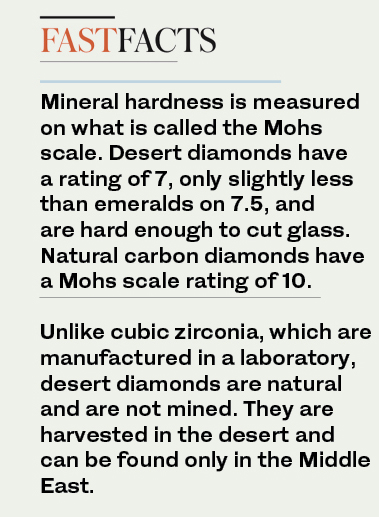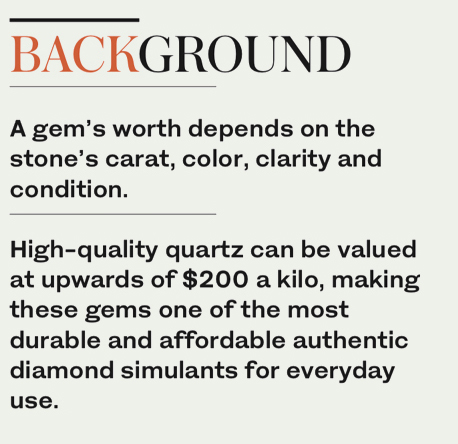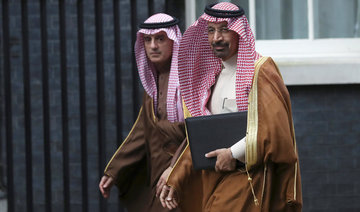JEDDAH: If you gaze for long enough along the Saudi desert horizon, especially around dawn or dusk, you will eventually notice a glittering sparkle on the surface of the dunes.
Your first impression may be that it comes from jewelry lost by desert trekkers. In fact, more often than not, what you see are desert diamonds — natural semi-precious gemstones found almost exclusively in the Arabian Peninsula.
The stones belong to the quartz family and come from the same micro-crystalline mineral as topaz and amethyst. When properly cut and polished, they have a luster and brilliance identical to that of far costlier carbon diamonds.
Although a few may be found in the UAE and Kuwait, desert diamonds are mainly harvested along the central desert plains of Riyadh. They are also known as Qaisumah diamonds, after the Saudi village where they were first discovered. Eons ago, rain washed millions of these metamorphic quartz gems downstream from the Hijaz mountains; the waters ran naturally into the Arabian Gulf and the sedimentary stones were deposited in what eventually became vast desert plains.
Natural sparkle
In their natural state, desert diamonds are simple river stones with a milky appearance. Hold them up to the sunlight, however, and there is a hint to their potential — they are completely translucent. Experts suggest the higher the translucency of the stone, the greater potential quality of the gem once it is ground, cut, and polished.
Desert diamonds are measured in carats and are slightly denser than full carbon diamonds, and thus are slightly smaller than carbon diamonds of identical weight.
 They are resistant to discoloration, do not break with age, and cannot even be scratched. Unlike the popular diamond simulant cubic zirconia, which are produced in laboratories and emit a rainbow-like shine, desert diamonds produce a purer, more natural sparkle — since they contain the same refractory properties as authentic full carbon diamonds.
They are resistant to discoloration, do not break with age, and cannot even be scratched. Unlike the popular diamond simulant cubic zirconia, which are produced in laboratories and emit a rainbow-like shine, desert diamonds produce a purer, more natural sparkle — since they contain the same refractory properties as authentic full carbon diamonds.
Searching for them is a great way to enjoy the outdoor life. “It’s always a fun activity to do with friends whenever we go out desert trekking,” says Yasmin Khayat, 26, from Jeddah, who likes to take a break from her job as an auditor by exploring the desert.
“Just like treasure hunters around the world who go to the beach with metal detectors, we look for that special sparkle in the sand. It’s a competitive activity because sometimes it’s very difficult to find them, and other days there are many on the surface. The wind cycle is the big determining factor. After a sandstorm is always the best time because many diamonds that were buried come to the surface.”
Of course, it isn’t only amateur gem-hunters who are interested in desert diamonds. Sally Cowley, founder and managing director of Desert Diamond Global Group, told Arab News:
“I started my business 20 years ago in Saudi Arabia, and we worked with natural quartz. Quartz, like other semi-precious stones from the topaz family, are fairly inexpensive, and over time processes have changed and developed and so has our selection of stone.
“Now we are based in Thailand, but in the beginning, our stone was quartz based as this was the best stone available that met our requirements. My passion is creating a collection of exceptional jewelry that delights the customer.”

Sally Cowley
While most people prefer the shine and luster of a professionally polished cut stone, many also like desert diamonds in their naturally rough and uncut state. The larger stones are commonly worn as a pendant, while the smaller stones can be incorporated into unique translucent quartz earrings.
Preservation
The refining process often involves a lengthy journey. Surprisingly, very few jewelers in Saudi Arabia can take on the task of transforming the rough stones into sparkling personal ornaments. Most desert diamonds are sent to Thailand for processing.
The raw stone is usually cut into a simple rectangular or square shape. It is then chemically treated to ensure the preservation of hardness and clarity, followed by a grinding process as the gem takes its final form.
Lastly, the cut stone is polished and, if required, set in a mount of precious metal such as gold, silver or platinum.
A gem’s worth depends on the stone’s carat, color, clarity and condition.
High-quality quartz can be valued at upwards of $200 a kilogram, making these gems one of the most durable and affordable authentic diamond simulants for everyday use.




























